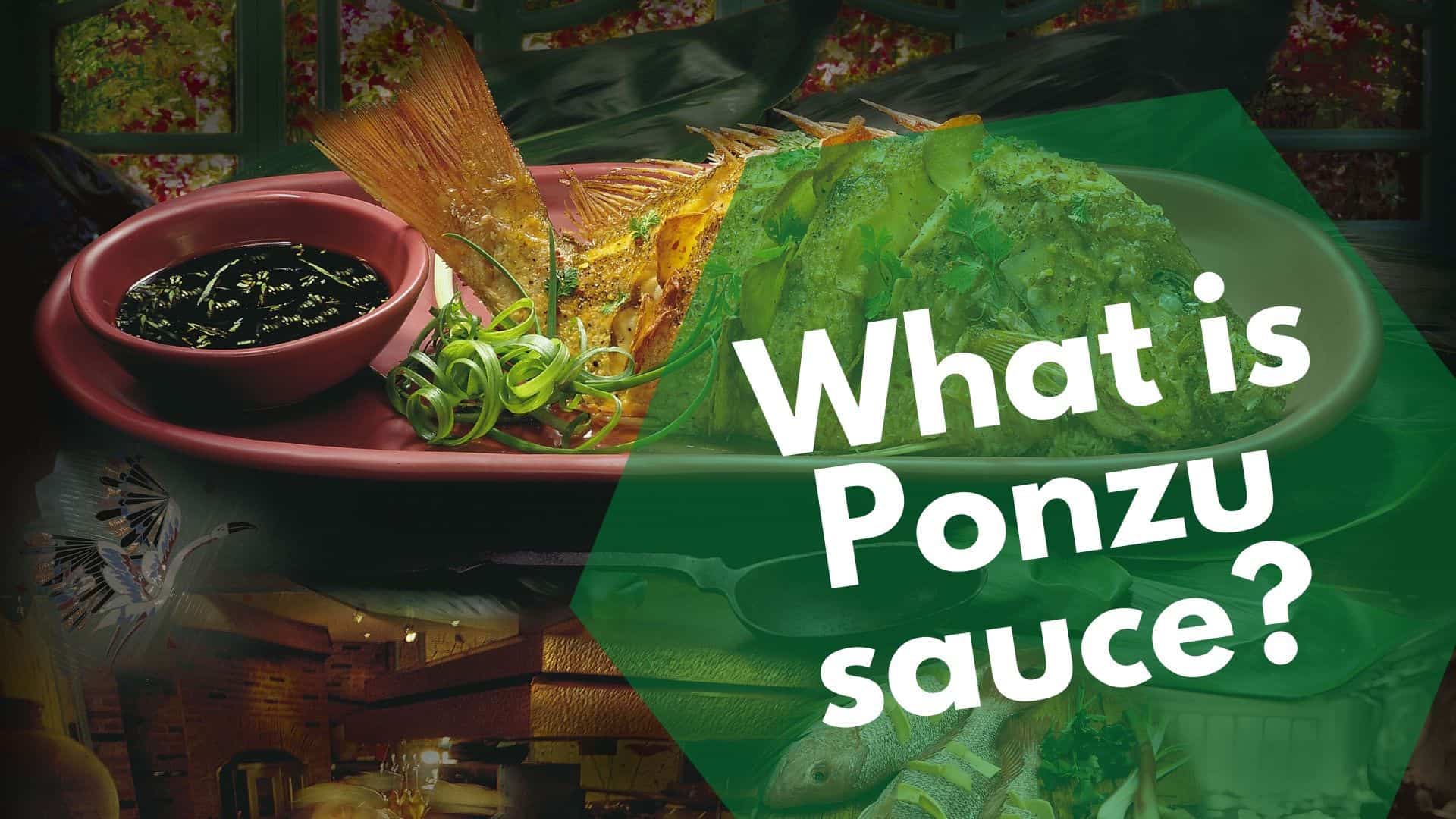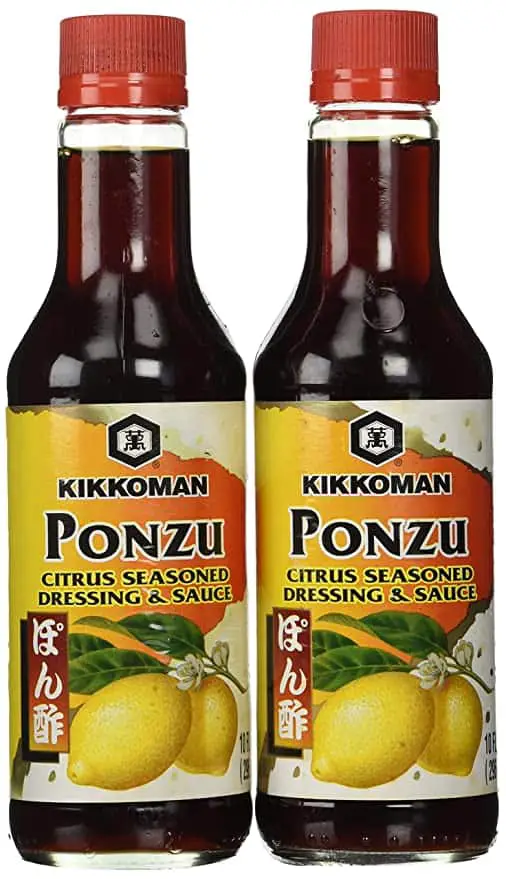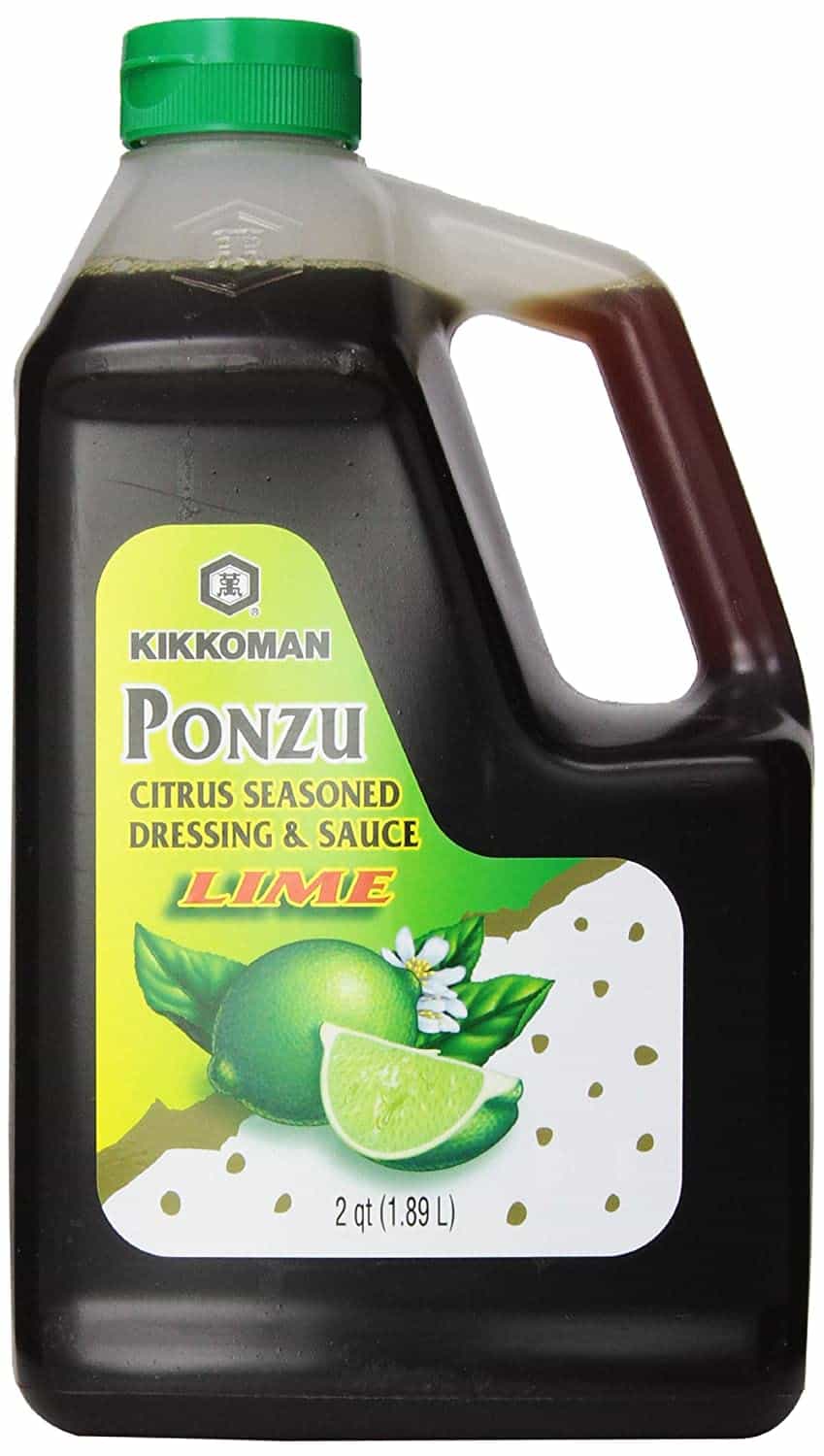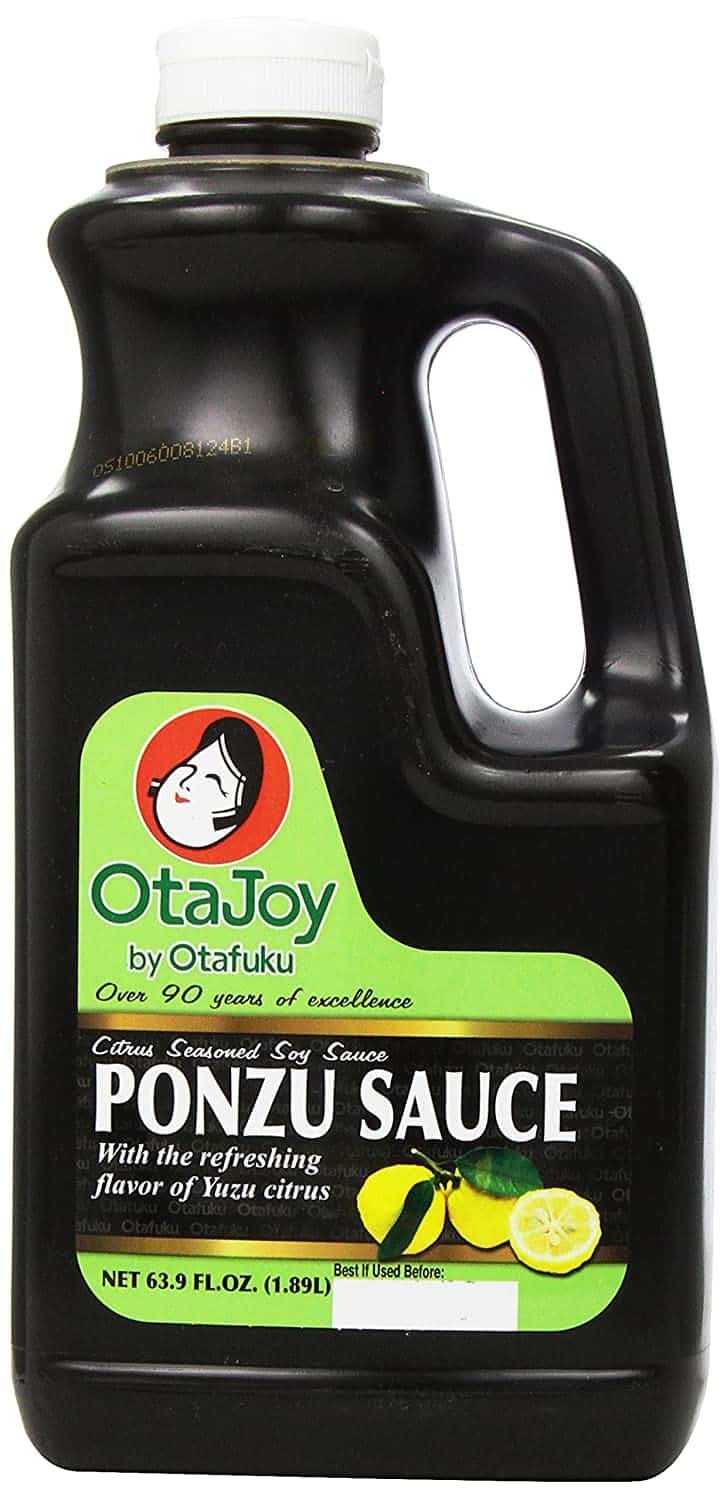What is ponzu sauce? Your guide on this citrusy Japanese deliciousness
If you enjoy adding flavor to your Japanese cuisine, then it’s likely that you’ve tried ponzu sauce.
This delicious citrus-based dipping saucehas a tart, salty, savory taste and a thin, watery texture.
It’s used as a dressing for tataki (lightly grilled and chopped meat or fish). It can also be a dip for nabemono (one-pot dishes) and sashimi.
In addition, it’s a popular topping for takoyaki!

This dipping sauce is made by mixing mirin, rice vinegar, katsuobushi flakes, soy sauce, and seaweed. Then, you let the mixture steep overnight!
Once the liquid is cooled and strained, citrus juices are added (such as lemon juice).
Curious about this tasty sauce?
Then read on to find out everything you’ve ever wanted to know about this Japanese citrus dipping sauce! I’ll also tell you how to make homemade ponzu sauce.

Check out our new cookbook
Bitemybun's family recipes with complete meal planner and recipe guide.
Try it out for free with Kindle Unlimited:
Read for freeIn this post we'll cover:
What is ponzu sauce?
Ponzu is a citrus-based sauce commonly used in Japanese cuisine. It’s tart, with a thin, watery consistency and a dark brown color.
Ponzu shōyu or ponzu jōyu (ポン酢醤油) is ponzu sauce with soy sauce (shōyu) added, and the mixed product is widely referred to as simply ponzu.
The element “pon” arrived in the Japanese language from the Dutch word “pons” (which in turn is derived from and shares the meaning of the English word “punch”).
“Su” is Japanese for vinegar. So the name literally means “pon vinegar”.
Origin of ponzu sauce
No one is really sure how ponzu sauce originated. However, there’s some information on the origin of its name.
We know that “pon” comes from the Dutch word “punch”. It’s one of the few words that still has an influence on the Japanese language.
This dates back to the 17th century when the Dutch East India Company were the only Westerners welcome to trade with isolationist Japan.
And of course, “zu” means “vinegar”, so the two together suggest the sauce has a punchy acidic taste.
Although there’s a Dutch influence on the name, the ingredients and method of cooking are purely Japanese.
Making your own ponzu sauce
Making homemade ponzu sauce is very easy and there’s almost no trick to it.
You gather the ingredients and follow my cooking and preparation procedures, and you’re good to go.
Find the full recipe for making your own ponzu sauce at home here.
Substitute and variations
Check out some of these substitutes and variations that you can use to make your ponzu dipping sauce.
Using yuzu juice instead of lime or orange juice
Yuzu fruit is often used in Japan as an ingredient in various Japanese cuisines. For instance, it’s a major ingredient in yuzu kosho, a condiment made of yuzu fruit peels, fresh chilies, and seasonings. So, if you want to go more traditional, you can substitute your regular lime or orange juice with yuzu fruit.
Using tamari instead of soy sauce to make it gluten-free
If you can’t eat gluten but yet want all the flavor of soy sauce, tamari is a perfect substitute. Tamari is made in a manner remarkably similar to that of soy sauce but without the use of wheat.
Don’t worry about the other ingredients, as you can easily find them in Japanese stores or any other Asian stores, or buy them online.
How is traditional ponzu sauce made?
Ponzu is traditionally made by simmering mirin, rice vinegar, katsuobushi flakes (from tuna), and seaweed (kombu) over medium heat.
The liquid is then cooled, strained to remove the katsuobushi flakes, and finally the juice of one or more of the following citrus fruits is added: yuzu, sudachi, daidai, kabosu, or lemon.
Commercial ponzu is generally sold in glass bottles, which may have some sediment.
Ponzu shoyu is traditionally used as a dressing for tataki (lightly grilled, then chopped meat or fish), and also as a dip for nabemono (one pot dishes) such as shabu-shabu.
It is used as a dip for sashimi. In the Kansai region, it is offered as a topping for takoyaki.
How to serve and eat
Ponzu sauce is a versatile condiment that can be used in many different ways. Here are some serving and eating suggestions.
- As a dipping sauce for tempura
- As a marinade for grilled chicken or fish
- As a dressing for salads
- As a flavoring for soup
- As a stir-fry sauce
Ponzu sauce is best when served cold or at room temperature. So, if you’re using it as a marinade, make sure to take the dish out of the fridge about 30 minutes before serving. And that’s it!
Now you know everything there is to know about ponzu sauce. So, go ahead and enjoy this delicious condiment in all your favorite dishes.
Bon appetite!
How do you use ponzu sauce?
Ponzu sauce can be used in recipes, but here are some other great ways to incorporate it into meals:
- To finish a dish: Right before you’re ready to serve a dish, add a few dashes of ponzu sauce. It’ll elevate the flavors of a stew or stir fry.
- In a marinade: Adding ponzu sauce to a marinade can give your steak or pork that extra something.
- In a salad dressing: Ponzu works well in a dressing served with a mixed green salad.
- As a dipping sauce: Ponzu makes a terrific dipping sauce for chicken dumplings and other appetizer-type foods.
- In burgers: Ponzu sauce can be used to substitute Worcestershire sauce to make any kind of burger tastier. This includes meat, chicken, turkey, and veggie burgers. It’s also great in meatloaf.
Can’t find ponzu sauce? Here are 16 best ponzu sauce substitutes & recipes to recreate the perfect taste
Similar dishes
If you fancy trying ponzu sauce or similar dishes, check out some of these food gems.
Worcestershire sauce
This sauce and ponzu sauce are quite comparable. Instead of the ponzu sauce’s tangy citrus juice and bonito flakes, it has tamarind and anchovies.
Lemon juice
One of the most adaptable components that can be used in place of ponzu sauce is lemon juice. Additionally, they are beneficial to eat because they are rich in vitamins, minerals, and nutrients.
Yuzu kosho
Yuzu kosho is a pasty Japanese condiment made of fresh chiles (typically green or red Thai or bird’s eye chilies), salt, and the juice and zest of the acidic, aromatic yuzu citrus fruit, which is native to East Asia.
Teriyaki sauce
To generate its powerful flavor, the traditional Japanese teriyaki sauce includes soy sauce, mirin, sugar, and sake. Westernized versions add honey, garlic, and ginger for extra pungency. Teriyaki sauce frequently contains cornstarch as a thickener.
So there you have them. Just go and try all of them to satisfy your Japanese sauce or condiment cravings.
FAQs
Need to know more about this delicious soy sauce-citrus sauce? I’ve got you covered!
What are some recipes that use ponzu sauce?
Not only can you make homemade ponzu sauce, but there are also plenty of recipes you can make that have ponzu sauce in them.
We recommend this ponzu sauce recipe for chicken sate!
Ingredients:
- 4 (6 oz.) skinless, boneless chicken breast halves
- ¼ cup packed light brown sugar
- ¼ cup sake (rice wine)
- ¼ cup rice vinegar
- ¼ cup fresh lemon juice
- 2 tsp low sodium soy sauce
- 1 tsp dark sesame oil
- ¼ tsp crushed red pepper
- 1 clove minced garlic
- Cooking spray
Directions:
- Cut each breast lengthwise to make them into 4 strips each.
- Combine sugar and remaining ingredients in a small bowl (except cooking spray). Stir until sugar dissolves. Combine half of the mixture with the chicken in a large bowl and let stand for 10 minutes.
- Drain chicken, discard marinade. Thread each chicken strip onto an 8” skewer. Place chicken on grill rack coated with cooking spray and grill 2 minutes each side. Serve with remaining sake mixture.
How nutritious is ponzu sauce?
Ponzu sauce does not rank very high on the nutrition scale.
If you look at a nutrition label on a bottle of dipping sauce, you’ll see that it contains none of the necessary daily nutrients. It’s also high in sodium, making it not the best choice for those on a low-salt diet.
Ponzu sauce also isn’t vegan due to its fish flakes.
In addition, it contains soy sauce, which has wheat in it. So it’s not gluten-free.
Due to its high sugar content, it also isn’t keto-friendly.
On the bright side, this classic Japanese citrus sauce is low in calories (only around 10 calories for a 1 tbsp serving) and it’s fat-free!
What is spicy ponzu?
If you like your ponzu with a kick, spicy varieties are available at the grocery store.
You can also make homemade ponzu sauce that’s extra spicy by adding sriracha chili sauce or chili oil to the recipe.
To give you an idea, here’s an example of a spicy ponzu sauce recipe:
Ingredients:
- 1 cup bottled ponzu sauce
- 1 cup soy sauce
- ½ cup mirin
- ½ cup rice vinegar
- 1 5” piece konbu (dried sea kelp)
- 1 tbsp katsuobushi (dried smoked bonito chips)
- Juice from ½ orange
- 1 tsp Asian chili oil
- 1 tsp sriracha chili sauce
- 12 oz mixed greens, including oak leaf, romaine, radicchio, bibb, and lola rosa
Directions:
- Combine ponzu sauce, soy sauce, rice wine, vinegar, sea kelp, bonito flakes, and orange juice in a medium bowl. Cover with plastic wrap. Put it in the refrigerator to mature for 2 weeks.
- Strain mixture through a fine sieve into a clean jar with a tight-fitting lid. Discard solids. (Dressing will keep in the refrigerator for up to 3 months.)
- Put chili oil, chili sauce, and 1/3 cup of ponzu dressing in a large bowl and whisk until smooth. Add greens and toss until well coated.
What are the best store-bought ponzu sauces?
You can make your own ponzu sauce or you can also buy it at Asian and American grocery stores. It’s available in glass or plastic bottles.
If you’re looking to buy ponzu sauce in the store, it looks like Kikkoman has a monopoly. Kikkoman offers regular ponzu sauce in various size bottles.

They also have lime ponzu:

Kikkoman is a trusted brand known for bringing Asian products into American markets. Their ponzu sauce will definitely provide the taste you’re looking for.
Ota Joy also has a Ponzu sauce that’s worth trying:

Ota Joy has a long history of bringing Japanese food products to markets around the globe. The company has made a reputation for guaranteeing high quality and great taste.
Have fun dipping your food in ponzo sauce
Well, now you know what ponzu sauce is, how to make it, where to buy it, what it can be substituted with, its nutrition facts, and more.
The only thing you have left to do is try it or make it for yourself! What will your ponzu sauce culinary adventure entail?
Also read: the top sushi sauces you must try
Check out our new cookbook
Bitemybun's family recipes with complete meal planner and recipe guide.
Try it out for free with Kindle Unlimited:
Read for freeJoost Nusselder, the founder of Bite My Bun is a content marketer, dad and loves trying out new food with Japanese food at the heart of his passion, and together with his team he's been creating in-depth blog articles since 2016 to help loyal readers with recipes and cooking tips.
